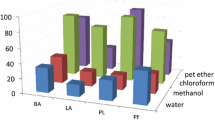Abstract
Limonin, deoxylimonin, citrolin, obacunone, harrisonin and acetoxyharrisonin were assayed as potential antifeedants against the African crop pests, Spodoptera exempta, Eldana saccharina and Maruca testulalis. Even at the highest applied concentration, limonin, deoxylimonin, citrolin and acetoxyharrison were not active against S. exempta. At high concentrations, obacunone and harrisonin were mildly active in S. exempta assays. Harrisonin and obacunone displayed potent activity against E. saccharina and M. testulalis.
Résumé
La limonine, la deoxylimonine, le citroline, l’obacunone, l’harrisonine et l’acetoxyharrisonine étaient tous essayés comme anti-nourrissants potentiels contre les pestes des plantes Africains sur la liste suivante: Spodoptera exempta, Eldana saccharina et Maruca testulalis. Mème avec le plus grand niveau de concentration appliqué, la limonine, la deoxylimonine, le citrolinine et l’acetoxyharrisone n’étaient pas actives contre S. exempta. Avec beaucoup de concentrations de liquide, l’obacunone et l’harrisonine ont montré très peu de reponse dans l’analyse de S. exempta. L’harrisonine et l’obacunone ont montré l’activité potentielle contre E. saccharina et M. testulalis.
Similar content being viewed by others
References
Barton D. H. R., Pradhan S. K., Sternhell S. and Templeton J. F. (1961) Triterpenoids. Part XXV. The constitution of limonin and related bitter principles. J. Chem. Soc. 255–275.
Butterworth J. H. and Morgan E. D. (1968) Isolation of a substance that suppresses feeding in locusts. J. Chem. Soc. Chem. Commun. 23–24.
Dreyer D. L. (1965) Citrus bitter principles. II. Application of NM R to structural and stereochemical problems. Tetrahedron 21, 75–87.
Gill J. S. and Lewis C. T. (1971) Systemic action of an insect feeding deterrent. Nature, Lond. 232, 402–403.
Henderson R., Morindle R. and Querton K. H. (1964) Salanin. Tetrahedron Lett. 3969–3974.
Klocke J. A. and Kubo I. (1982) Citrus limonoids byproducts as insect control agents. Entomologia exp. appl. 32, 299–301.
Kraus N., Cramer R., Bokel M. and Sawitzki G. (1981) New insect antifeedants from Azadirachta indica and Melta azadiracht. In Proceedings of the 1st Neem Conference, Rottach-Egern F. R. G. June 1980, pp. 267–277. Deutsche Gesellschaft für Technische Zusammenarbeit (GTZ), Eschborn.
Kubo I. and Klocke J. A. (1982) Limonoids as insect control agents. INRA Publ., Les Colloques de L’iNA, No. 7, Verssailes pp. 16–20, November 1981.
Kubo I., Tanis S. P., Lee Y. W., Miura I., Nakanishi K. and Chapya A. (1976). The structure of harrisonin. Heterocycles 5, 485–497.
Lavie D. and Jain M. K. (1967) Tetranortriterpenoids from Melia Azadirachta L. Chem. Commun. 278–280.
Liu H.-W., Kubo I. and Nakanishi K. (1982) A southern armyworm antifeedant, 12-acetoxyharrisonin from an African shrub Harrisonia abyssinica. Heterocycles 17, 67–71.
Nakatani M., James J. C. and Nakanishi K. (1981) Isolation and structure of Trichilins, antifeedants against the southern armyworm. J. Am. chem. Soc. 103, 1228–1230.
Rembold H., Sharma G. K., Czoppelt C. H. and Schmutterer H. (1981) Azadirachtin: A potent insect growth regulator of plant origin. Z. angew. Ent. 93, 12–17.
Ruscoe C. N. E. (1972) Growth disruption effects of an insect antifeedant. Nature, New Biol. 236, 159–160.
Saxena R. C., Justo H. D. and Epino P. B. (1984) Evaluation and utilization of neem cake against the rice brown planthopper, Nilaparvata lugens (Homoptera: Delphacidae). J. econ. Ent. 77, 502–507.
Warthen J. D. Jr (1979) Azadirachta indica: A source of insect feeding inhibitors and growth regulators. U.S. Dept Agric. Rev. Man. ARM-NE-4.
Webb R. E., Hinebaugh M. A., Lindquist R. K. and Jacobson M. (1983) Evaluation of aqueous solution of neem seed extract against Liriomyza sativae and L. trifoli (Diptera: Agromyzidae). J. econ. Ent. 76, 357–362.
Zanno P. R., Iwao M. and Nakanishi K. (1975) Structure of insect phagorepellent azadirachtin. Application of PRFT/CWD carbon-13 nuclear magnetic resonance. J. Am. chem. Soc. 97, 1975–1977
Author information
Authors and Affiliations
Rights and permissions
About this article
Cite this article
Hassanali, A., Bentley, M.D., Ole Sitayo, E.N. et al. Studies on Limonoid Insect Antifeedants. Int J Trop Insect Sci 7, 495–499 (1986). https://doi.org/10.1017/S1742758400009711
Received:
Published:
Issue Date:
DOI: https://doi.org/10.1017/S1742758400009711
Key Words
- Antifeedants
- limonoids
- tetranortriterpenoids
- Spodoptera exempta
- Maruca testulalis
- Eldana saccharina
- limonin
- deoxylimonin
- citrolin
- obacunone
- harrisonin
- acetoxyharrisonin




